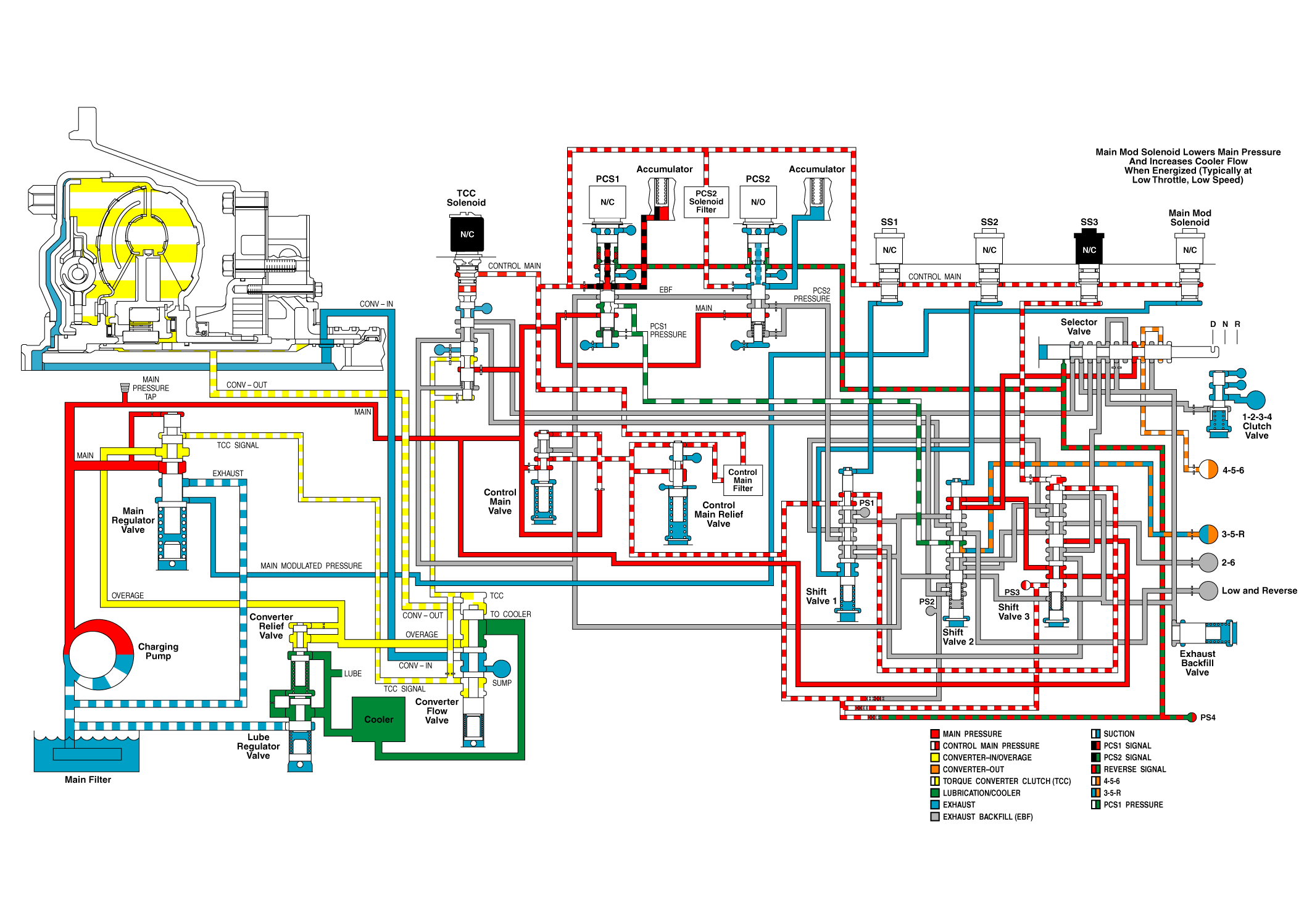Before making a shift from fourth to fifth range, the transmission control module (TCM) makes certain all of the shift valves are in the correct position with shift valve 1 and shift valve 3 stroked and shift valve 2 de-stroked.
Pressure control solenoid 2 (PCS2) is de-energized, exhausting PCS2 signal pressure and pressure control valve 2 de-strokes, which allows the 1-2-3-4 clutch to exhaust through the manual selector valve, shift valve 3 and shift valve 1, and pressure control valve 2. PCS1 is de-energized, raising the PCS1 signal and pressure control valve 1 pressures. PCS1 pressure is directed through shift valve 2 to the 3rd, 5th, and reverse clutch, applying the clutch. The TCM reduces the current to PCS1, which controls the rate at which pressure control valve 1 supplies pressure to the 3rd, 5th, and reverse clutch, and reduces the current to PCS2, which controls the rate at which pressure control valve 2 exhausts the 1-2-3-4 clutch, assuring a smooth transition from fourth to fifth range. The 4-5-6 clutch continues to be applied by main pressure flowing through shift valve 3, shift valve 2, and the manual selector valve.
The combination of the 4-5-6 clutch and the 3rd, 5th, and reverse clutch application produces fifth range operation.
Pressure switch 1 and pressure switch 2 are turned OFF, providing feedback that shift valve 1 and shift valve 2 are in the de-stroked position, and pressure switch 3 remains ON, providing feedback that shift valve 3 is in the stroked position.
If electrical power is interrupted while the transmission is in fifth range, PCS2, shift solenoid 3 (SS3), and the torque converter clutch (TCC) solenoid (if TCC is applied) de-energize. Although SS3 no longer supplies control main pressure to the top of shift valve 3, control main pressure flows through shift valve 1 to the top of shift valve 3, keeping the valve stroked. Normally closed PCS1 continues to block the exhaust of the signal pressure (signal remains control main). The signal pressure on top of pressure control valve 1 produces maximum control pressure, which is routed through shift valve 2 to the 3rd, 5th, and reverse clutch, keeping the clutch applied. Main pressure feeds through shift valve 3 and shift valve 2 and the manual selector valve to the 4-5-6 clutch, keeping the clutch applied.
The combination of the 4-5-6 clutch and the 3rd, 5th, and reverse clutch application produces fifth range operation for limp home capability.
If the TCC is applied, the TCC solenoid de-energizes, causing the TCC pressure control valve to de-stroke, exhausting pressure from the top of the converter flow valve. The converter flow valve de-strokes, redirecting main overage to converter in and converter out flow to the cooler. The TCC is now released.
If electrical power is interrupted while the transmission is in fifth range (causing fifth range converter operation) and the manual selector valve is moved to Neutral (N), the 4-5-6 clutch exhausts through the manual selector valve to exhaust backfill, releasing the 4-5-6 clutch. The 3rd, 5th, and reverse clutch remains applied. With only one clutch applied, the transmission goes to neutral.
If electrical power is interrupted while the transmission is in fifth range, (fifth range converter operation) and the manual selector valve is moved to Reverse (R), the 4-5-6 clutch exhausts through the manual selector valve, releasing the clutch. The 3rd, 5th, and reverse clutch remains applied. With only one clutch applied, the transmission goes to neutral.
If electrical power is interrupted while the transmission is in fifth range, resulting in only fifth and neutral operation, the engine may be shut down and restarted to attain neutral, third and reverse operation.
Fifth Range

